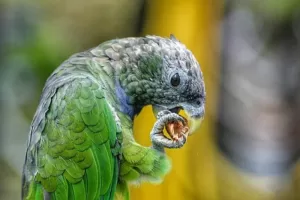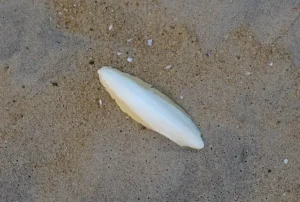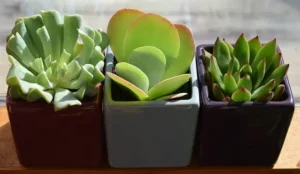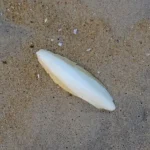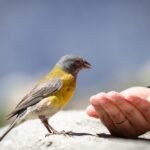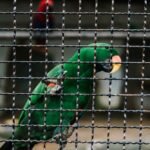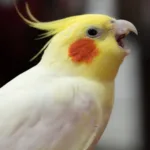Bumblefoot or Pododermatitis is the inflammation of the foot pads. It affects parrots of all ages but is more commonly seen in older birds.
Bumblefoot is a bacterial infection that occurs when a parrot’s foot becomes contaminated through an open cut or skin wound, leading to inflammation and ulceration of the foot. There are other factors such as nutrition, hygiene, weight, and perch that can also contribute to the development of this condition.
Pododermatitis is a degenerative disease, which means it affects the tissues and bones of the foot leading to deterioration over time. If left untreated, it can lead to foot deformities and a complete loss of function. This is why it is essential to know the early signs and symptoms of bumblefoot in parrots in order to take preventative action.
Quick Navigation
What Does Bumble Foot Look Like At Different Stages?
Bumblefoot in parrots often begins at the underside of the feet or the digit pads. In the early stages, the skin on the foot may appear red with some scaling, and thinning. The inflammation can progress further and infect the tissues under the skin. Eventually, it may lead to abscesses of the foot and bone infection.
Bumblefoot in parrots is classified into different grades based on the severity of the condition. According to the World Association for Veterinary Dermatology, there are five grades of avian pododermatitis.
| Grade | Description |
| I | The infection has only affected the plantar surface (outer layer of the skin) and hasn’t spread deeper yet. Redening of the skin may be observed, along with loss of papilla (small bumps on the skin), and excessive thickening of the skin (hyperkeratosis). |
| II | Infection of subcutaneous tissues with clear signs of inflammation like redness and swelling. The feet may become discolored or black due to ischemic necrosis. |
| III | The parrot’s feet may become swollen and painful, but there may not be any apparent damage to structures deep inside the feet. There may be a fluid discharge from a fibrotic (scarred) area. |
| IV | The infection has spread to vital parts of the foot, including tendons and bones. The parrot may develop other conditions such as tenosynovitis (inflammation of the tendon sheath) and osteomyelitis (bone infection). |
| V | The disease has progressed significantly causing osteomyelitis (infection of the bones). This leads to foot deformities and a complete loss of function in the feet. The prognosis is extremely serious, and in many cases, euthanasia is considered to prevent further suffering. |
Symptoms Of Bumblefoot
The early symptoms of bumblefoot are visible on the parrot’s foot. The skin on the bottom of the feet will have reddening and sores. As the condition worsens it can progress to ulcers. If left untreated for long, the infection can reach deep below the skin causing discoloration of the foot.
The parrot may still be able to use its feet, but it can be difficult to perch or walk properly. Behavioral signs like limping and perching issues may not surface early as parrots often try to hide their pain. The parrot will eventually avoid the perch and go to the bottom of its cage. Symptoms of pododermatitis in parrots include:
- Limping
- Swollen footpad
- Inability to perch
- Sitting at the bottom of the cage
- Standing on one leg
- Sores
- Abscesses
- Discoloration of the feet
- Lameness
- Overgrown nails
Causes Of Bumble Foot
Bumblefoot is caused by the bacteria, Staphylococcus, which infects a parrot’s foot. However, there are other factors that play a role. According to the MSD Veterinary Manual, bumblefoot develops most commonly in birds housed with inappropriate perches or those with an injury of the foot.
These may include cuts, scrapes, and lesions which provide an opening for the bacteria to make its way to the inside of the parrot’s feet. Here are some common ways parrots can develop bumblefoot:

Unsanitary Living Environment
Bacteria and other microorganisms thrive in an unclean environment, so if your parrot’s living quarters are not well kept, it can become a breeding ground for the bacteria responsible for bumblefoot and other infections.
Parrots generally make a lot of mess around their cages, which is why it is important to regularly clean the area and avoid letting perishable food out for long periods.
Inappropriate Perches
Improper perches are a common cause of pododermatitis in parrots. The perch is the surface a parrot’s feet make contact with most often. Certain types of perches aren’t suitable for long-term use.
Sand perches and can scrape through layers of the foot allowing bacteria to get in. This is an important reason why perches should be cleaned regularly as they can accumulate dirt and grime.
Wounds
Bumblefoot spreads when bacteria enter the parrot’s skin, typically from a wound. It needs an entry point to the parrot’s feet. Even Small cuts and abrasions can leave an opening for the bacteria to invade and spread.
Previous Injuries
Parrots with a history of foot conditions or injuries are at a higher risk of getting affected by bumblefoot. If a parrot has an injured leg, it may prefer to shift the weight to the good foot, placing extra weight and potentially causing ulceration of the plantar surface.
Vitamin A Defificniey
Nutritional problems, particularly Vitamin A deficiency can increase the chances of contracting bumblefoot. According to the Veterinary Research Forum, some forms of bumblefoot can be caused by a vitamin A deficiency. Most often, parrots that are on a seed-only diet lack essential nutrients.
Overgrown Nails
Overgrown nails can lead to balancing issues in parrots, causing them to perch improperly. This improper perching can put excessive pressure on one leg, potentially leading to the development of sores. Parrots can also injure themselves if their nails are not trimmed.
Obesity
When a parrot is overweight, it puts excessive strain on its feet when standing up. The pressure from the extra weight can increase the risk of injuries and also potentially lead to the development of sores.
Bumblefoot Treatment Options For Parrots
The course of treatment for bumblefoot varies based on the seriousness of the condition. If you discover signs of bumblefoot in your parrot early on, you can manage the condition at home. Firstly, you should clean out the wound to prevent the bacteria from entering your parrot’s skin.
You can use Epsom salt to reduce swelling and reddening of the feet. Gently wrap your parrot in a towel, keeping the foot exposed, and soak it in a bath made of Epsom salt for about 10-15 minutes, once or twice a day.
Woundcare And Bandaging
In mild cases of bumblefoot, the condition can be managed by treating the wound. Since the infection is on the plantar surface, it can be healed with bandages and thorough cleaning.
Along with that, the underlying causes for the issue should also be addressed. That includes replacing improper perches, cleaning the cage often, and providing a nutritionally balanced diet.
Topical Medication And Antibiotics
Vet-prescribed topical treatments, like creams or ointments, can be used to treat bumblefoot. While applying antibiotic creams, you need to be careful as they can be harmful if ingested by the bird. The vet may also prescribe oral medications and antibiotics in cases where the infection has reached deeper.
Surgical Intervention
If pododermatitis is found in more advanced stages (grade 3 or higher), surgery is often needed to remove infected or dead tissue and promote drainage if there’s an abscess. This is needed to stimulate the growth of new tissue and improve blood flow to the area.
In extremely serious cases when pododermatitis is accompanied by issues like tendon problems, severe bone infections, or loss of limb function, amputation might be considered as a last resort.
How To Prevent Bumblefoot In Parrots?
There are certain things you need to be careful with to avoid the development of pressure sores in your parrot:
Maintain Hygiene
The best way to prevent pododermatitis or any other bacterial infection for that matter is to maintain hygiene in the parrot’s cage area. Bacteria can live inside your parrot’s cage and on its perch if it is generally dirty. So ensure that you clean the living area every couple of days.
Treat Wounds Promptly
The only way bacteria can enter your parrot’s foot is through skin wounds. Every once in a while parrots can get small cuts and abrasions from playing and exploring their environment.
Something as simple as the cage bars can sometimes scrape your parrot’s feet. You should treat those injuries promptly and even cover them with a bandage so that it is safe from bacteria.
Check On Your Parrot’s Feet Regularly
Bacteria can reach your parrot’s foot when there is a cut or injury in the footpad. You need to regularly check your parrot’s feet for any kind of injury especially since they have a tendency to hide their weaknesses. If your parrot has an injury in its leg or feet, it will naturally resort to concealing it.
Parrots are quite good at concealing their injuries as it helps them survive in the wild. However, they may not be able to hide their limping movements and perching difficulty. You need to be able to recognize these symptoms and prevent this injury from progressing further.
Provide A Variety Of Perches
Parrots need a variety of perches. Each perch serves a different function for them. For example, sand perches can help keep the nails trimmed. But using them long-term can cause abrasions in the parrot’s feet.
Parrots can also benefit from a comfortable rope perch. For parrots with bumblefoot, you can use rope perches as they help alleviate the pain. You can also put towels and other soft cloth on a regular perch to make it warm.
While your parrot is recovering, you shouldn’t immediately allow them to sit on their regular perch. Their feet can still be sensitive from the healing sores and need something soft and cushioned to rest.
Cotton rope perches can be ideal for parrots with any kind of foot injury or condition. It is soft yet still sturdy for parrots to easily balance on.
Bumblefoot In Parrots FAQs
Is Bumblefoot Contagious To Other Parrots?
Bumblefoot is not contagious but the bacteria that causes it can spread if it comes in contact with another bird. The bacteria cannot be transferred by sharing the same food bowl and living together, however, you should not house an affected parrot with a healthy bird as it may not be safe.
Can Bumblefoot Be Fatal?
Bumblefoot can be fatal if it is left untreated. It is a degenerative disease that can spread to the tissues and bones causing permanent damage to the foot. Once the infection has reached the bones, the prognosis is very poor and may result in the parrot’s death.
Are There Any Home Remedies For Bumblefoot?
Bumblefoot can be managed at home if it is detected in the early stages. Appropriate wound care and bandages can help solve the issue. However, you should always consult an avian veterinarian to assess the situation.
How Long Does It Take for Bumblefoot To Heal?
There is no definitive amount of time for bumblefoot to heal. The course of treatment and recovery period depend on the severity of the condition. If the condition is detected in the early stages, it may take anywhere from a few weeks to a month for the parrot to get. However, if the treatment is delayed, the recovery period could be longer and the prognosis can be less optimistic.
